|
|
|
Sort Order |
|
|
|
Items / Page
|
|
|
|
|
|
|
| Srl | Item |
| 1 |
ID:
090344
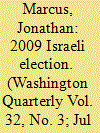

|
|
|
| 2 |
ID:
107142


|
|
|
| 3 |
ID:
138618
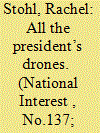

|
|
|
|
|
| Summary/Abstract |
WHEN THE Senate Select Committee on Intelligence released its “torture report” in December 2014, it reignited the battle over the George W. Bush administration’s conduct of the “war on terror.” Unfortunately, the interrogation program was not an anomaly in its lack of transparency. A similar problem exists with the U.S. drone program—which, after more than ten years of use and nearly two years after President Barack Obama’s speech promising greater transparency and accountability, remains shrouded in secrecy and uncertainty.
|
|
|
|
|
|
|
|
|
|
|
|
|
|
|
|
| 4 |
ID:
140335
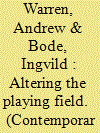

|
|
|
|
|
| Summary/Abstract |
This article will interrogate the degree to which the Obama administration has continued, even at times inadvertently, the Bush administration's challenge on international law. Notwithstanding the Obama administration's bold pronouncements pertaining to reversing its predecessor's policies, little has actually changed when it comes to how the USA considers using military force. As a means to unpack this transition, this article will firstly consider the apparent continuum of use-of-force policies from the Bush to the Obama administration, specifically: the American conflation in the line between pre-emptive and preventive self-defence options; the sustained post-September 11 legacies that continue to lower thresholds towards using military force; and how this ultimately contributes to the erosion of international law in this area. Secondly, this article presents a critical contextualization of Obama's drone programme and its legal arguments in relation to his administration's overall use-of-force policy, focusing on jus ad bellum standards. In light of the centrality of targeted killings under Obama, our article will pay particular attention to the contradiction this poses with regard to his reluctance to use military force in relation to ongoing conflicts in Libya and Syria, while also looking at recent adjustments pertaining to use-of-force pronouncements against the Islamic State (IS). The article lastly considers what this will mean for international use-of-force thresholds and the future of the general prohibition on the use-of-force in the context of new and emerging technologies and theaters should the USA continue to skew and adjust its use-of-force policies on when, how, against who and where to use such force.
|
|
|
|
|
|
|
|
|
|
|
|
|
|
|
|
| 5 |
ID:
103844
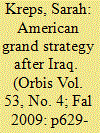

|
|
|
|
|
| Publication |
2009.
|
| Summary/Abstract |
To the extent that a grand strategy can be discerned in the first year of the Obama Administration, its defining features are not a break from the past but continuity. As the President himself has analogized since taking office, crafting grand strategy is like parallel parking. He has only been able to make changes to grand strategy around the margins since a number of existing commitments limit his freedom of action. This article first identifies the structural determinants of grand strategy, pointing to the international distribution of power, American bureaucracy, and public as the key sources of strategic constraint and opportunity. It then shows how shifts in these factors-comparatively less U.S. power, an overstretched military organized around counterinsurgency operations in Iraq and Afghanistan, and an American public weary from an aggressive grand strategy-produced a shift in grand strategy that predated the 2008 election and that remains consistent with the current strategic setting. It is for these reasons that the 2008 "change" election has produced considerable continuity in American grand strategy.
|
|
|
|
|
|
|
|
|
|
|
|
|
|
|
|
| 6 |
ID:
087849
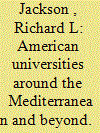

|
|
|
|
|
| Publication |
2009.
|
| Summary/Abstract |
The inauguration of President Barack Obama offers a historic opportunity to reshape America's interface with the world at large and to undo errors of commission, omission, and neglect of the past decade. US assets undervalued and underused in recent years will be rediscovered, including the network of accredited American colleges and universities around the globe: the Association of American International Colleges and Universities. This essay outlines the potential role of these institutions in shaping how the United States is seen in critical areas of the world and in serving as a beacon of American, private, nonprofit higher education. It also contains specific recommendations for how the Obama administration can strengthen, at minimal cost, the network of American institutions abroad without co-opting or using them as vehicles for US propaganda.
|
|
|
|
|
|
|
|
|
|
|
|
|
|
|
|
| 7 |
ID:
110206
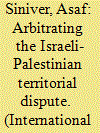

|
|
|
|
|
| Publication |
2012.
|
| Summary/Abstract |
This article presents the case for arbitrating the territorial dispute over the West Bank between Israel and the Palestinian Authority. After nearly two decades of intense intermediary activity but with still no signs of progress, and against the inability of the parties themselves to move towards reconciliation, the article argues that as a method of conflict resolution, mediation has exhausted its primary objective - namely the establishing of direct channels of communication between the disputants - and it is now time to examine alternative methods to conflict resolution. The article debunks the myths surrounding the success of American mediation in the conflict, and uses the historical case of the Taba arbitration between Israel and Egypt to demonstrate under what terms the arbitration of the West Bank dispute might be presented, while taking into consideration its advantages and drawbacks compared with the more established method of mediation in this conflict.
|
|
|
|
|
|
|
|
|
|
|
|
|
|
|
|
| 8 |
ID:
102060
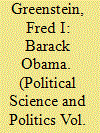

|
|
|
| 9 |
ID:
102295
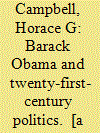

|
|
|
|
|
| Publication |
London, Pluto Press, 2010.
|
| Description |
xxiii, 319p.
|
| Standard Number |
9780745330068
|
|
|
|
|
|
|
|
|
|
|
|
Copies: C:1/I:0,R:0,Q:0
Circulation
| Accession# | Call# | Current Location | Status | Policy | Location |
| 055784 | 324.9730931/CAM 055784 | Main | On Shelf | General | |
|
|
|
|
| 10 |
ID:
141545
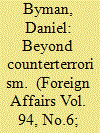

|
|
|
|
|
| Summary/Abstract |
When the Obama administration looks at the Middle East [2], it does so through the lens of counterterrorism. A systematic emphasis on the subject has underscored not just the administration’s relentless pursuit of al Qaeda and its new focus on the self-proclaimed Islamic State [3] (or ISIS) but also a wider swath of its foreign policy, from its drone campaign in northwestern Pakistan to its maintenance of the detention facility in Guantánamo Bay.
|
|
|
|
|
|
|
|
|
|
|
|
|
|
|
|
| 11 |
ID:
138545
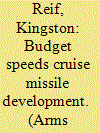

|
|
|
|
|
| Summary/Abstract |
The Obama administration is proposing to increase spending to accelerate by two years the development of a new nuclear-armed cruise missile, according to budget documents released
|
|
|
|
|
|
|
|
|
|
|
|
|
|
|
|
| 12 |
ID:
157695
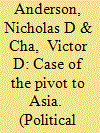

|
|
|
|
|
| Summary/Abstract |
NICHOLAS D. ANDERSON and VICTOR D. CHA discuss the origins of the pivot to Asia, the Obama administration’s strategy in the Asia-Pacific. They argue that the pivot was neither a failure, as its critics suggest, nor a success, as its supporters claim. For the authors the pivot was a midcourse adjustment to a weak and flawed early Obama Asia policy.
|
|
|
|
|
|
|
|
|
|
|
|
|
|
|
|
| 13 |
ID:
115193
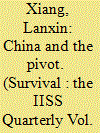

|
|
|
|
|
| Publication |
2012.
|
| Summary/Abstract |
The Obama administration seems to have toned down its rhetoric on Asia-Pacific security, abandoning the fancy but problematic phrase 'pivot towards Asia' and replacing it with the more prosaic 'rebalancing'. This does not mean the content of US policy is very different. On the contrary, the Obama administration continues its military build-up in the region, aiming at a military posture that can only be described as 'absolute superiority'. Over the past two years, Washington has put together a comprehensive 'containment' package in Asia that includes a new military doctrine of air-sea battle; launched a game-changing economic project called the Trans-Pacific Partnership; initiated the 'rotation' of US marines in Australia; and stationed coastal battleships in Singapore. More alarmingly, the United States is making clear attempts to re-establish a naval presence in Subic Bay in the Philippines, and in the coveted Cam Ranh Bay in Vietnam. Both were key US naval bases during the Cold War.
|
|
|
|
|
|
|
|
|
|
|
|
|
|
|
|
| 14 |
ID:
133795
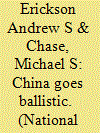

|
|
|
|
|
| Publication |
2014.
|
| Summary/Abstract |
China's growing missile and nuclear forces will pose a complex, challenging threat to America and its allies.
CHINA IS INCREASINGLY A FORCE TO BE RECKONED WITH, not only economically but also militarily. Its aggressive stance toward some of its neighbors, along with Asia's growing economic importance and the need to assure U.S. allies that Washington will increase its attention to the region despite budgetary challenges and fractious domestic politics, prompted the Obama administration to announce a "rebalance" toward Asia.
|
|
|
|
|
|
|
|
|
|
|
|
|
|
|
|
| 15 |
ID:
167739
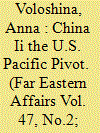

|
|
|
|
|
| Summary/Abstract |
In 2011, the U.S. Obama Administration officially put forward a geopolitical initiative that went down in history under the name of "pivot," or rebalance. A major element of that strategy, which was intended to guarantee U.S.A.'s dominant position in the Asia-Pacific Region (APR), became the building of constructive relations with China. This paper attempts to show how the Chinese vector of the pivot occurred and developed. Our analysis has yielded a conclusion about the changes that the pivot has undergone with the replacement of the U.S. administrations and also prompted a question about the efficiency of this strategy in terms of carrying out the objectives set by the United States.
|
|
|
|
|
|
|
|
|
|
|
|
|
|
|
|
| 16 |
ID:
144641
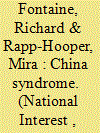

|
|
|
|
|
| Summary/Abstract |
CHINA’S RAPID ascent to great-power status has, more than any other international development, raised concerns about the future of the liberal international order. Forged in the ashes of the Second World War, that order has enabled a seven-decade period of great-power peace, the expansion of democratic rule and a massive increase in global prosperity. Now, it seems, world order is under threat—not least from China’s rising power. While Beijing has thus far avoided active military aggression and refrained from exclusionary economic arrangements, American policymakers worry quite openly about China’s challenge to the underlying rules of the road. They hope that Beijing will embrace the existing pillars of global order and even work to support them; they fear that China will prove revisionist, seeking to undermine the rules-based order and fashion an illiberal alternative that excludes the United States.
|
|
|
|
|
|
|
|
|
|
|
|
|
|
|
|
| 17 |
ID:
165759
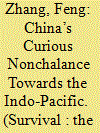

|
|
|
|
|
| Summary/Abstract |
China’s relaxed attitude derives in part from its assessment that it overreacted to the Obama administration’s ‘rebalance’ to Asia.
|
|
|
|
|
|
|
|
|
|
|
|
|
|
|
|
| 18 |
ID:
106259
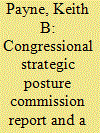

|
|
|
|
|
| Publication |
2011.
|
| Summary/Abstract |
The bipartisan Congressional Strategy Posture Commission offered numerous recommendations to reduce what it labeled "the nuclear danger." The Obama Administration has pursued some of these recommendations via its policy documents, such as the 2010 Nuclear Posture Review, its budgets, and plans. There is reason, however, for several concerns in this regard. These involve the high priority placed on nuclear force reductions at the potential expense of other national goals, including deterrence and assurance; the maintenance of the flexibility and resilience of the U.S. force posture necessary to meet deterrence and assurance requirements now and in the future; continued support for U.S. strategic defensive capabilities given Russian opposition; and apparent interest among some in the Administration to move increasingly toward what has been termed a policy of Minimum Deterrence.
|
|
|
|
|
|
|
|
|
|
|
|
|
|
|
|
| 19 |
ID:
106267
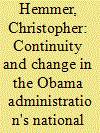

|
|
|
|
|
| Publication |
2011.
|
| Summary/Abstract |
This article examines the Obama Administration's recently released National Security Strategy (May 2010) and compares it with its predecessors. While consistent with its predecessors in its definition of American interests, its stress on U.S. global leadership, and the importance of American values in its foreign policy, it differs from the strategy released by the George W. Bush Administration by offering a more complex view of the international threat environment, favoring multilateralism, stressing America's example over its military might, and in acknowledging the limits of American resources. The fundamental flaw of the current National Security Strategy, a flaw it shares with all its predecessors, is that it ignores concessions, tradeoffs, and hard choices inherent in American foreign policy.
|
|
|
|
|
|
|
|
|
|
|
|
|
|
|
|
| 20 |
ID:
093196
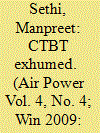

|
|
|
|
|
|
|
|